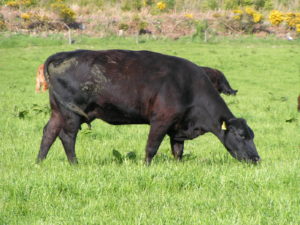Fog fever
20 September 2016 Fog fever is a condition usually seen in the autumn in adult cattle at grass. It is thought to be caused by the ingestion of a substance called L-tryptophan, which is converted in the rumen to substances which are toxic to lung tissue. The condition is most commonly seen within two weeks of a move from sparse to lush pasture. It is usually seen in beef cattle, most likely due to the uniformity of dairy cattle grazing.
Fog fever is a condition usually seen in the autumn in adult cattle at grass. It is thought to be caused by the ingestion of a substance called L-tryptophan, which is converted in the rumen to substances which are toxic to lung tissue. The condition is most commonly seen within two weeks of a move from sparse to lush pasture. It is usually seen in beef cattle, most likely due to the uniformity of dairy cattle grazing.
Mortality in severely affected animals can be high but usually only a small proportion of a group is obviously affected. However, when groups of cattle with severely affected individuals present are examined, up to 50% may be showing mild respiratory signs. There is a wide variation in the rate of onset and severity of clinical signs, with most cases occurring in the five days after exposure to the new pasture. Most deaths will occur in the first 2-3 days of an outbreak, and survival of an affected cow past five days is considered to give a good idea of whether that animal will recover.
Severely affected cattle have difficulty breathing. They often grunt on breathing out, and froth at the mouth. They tend to be distressed, with open-mouthed breathing, but remain alert. They do not graze, and stand apart from the rest of the herd.
The other cause of pneumonia in cattle at grass is lungworm, and this needs to be ruled out. There are a couple of clues which can help to tell the difference between the two conditions. Unlike lungworm, cattle with fog fever tend not to cough. Additionally, fog fever is almost always seen only in cattle over two years of age. If calves at foot are also affected, then lungworm is the more likely diagnosis.
There is no specific treatment for this condition, but supportive treatment may be given. In some outbreaks it may be appropriate to move affected cattle inside. However, the stress associated with movement may hasten death in severely affected animals. If animals cannot be moved inside easily then the provision of supplementary feeding to lessen the intake of grass may be more appropriate. Severely affected animals may require immediate slaughter.
The previously grazed pasture may be poor, or may have been subjected to a prolonged period of grazing. The new pasture may or may not have been grazed during that summer, but usually there is regrowth of lush grass, legume or other palatable plants. The condition is often seen after a move to hay or silage aftermath. Most cases of the disease occur on pasture which has been fertilised. No specific species of grass or plants have been linked with the disease but the disease may recur on the same pasture in successive years. Following the first frost in the autumn the incidence of the disease tends to decline rapidly.
Prevention of this condition is through pasture management, gradually increasing grazing time over a period of 10-12 days. Because young stock are thought to be more tolerant to L-tryptophan, they can be used to graze lush pasture first. Strip grazing can also be useful, as can pre-feeding the cows so they are not being turned out onto lush pasture when they are hungry.
Katrina Henderson, katrina.henderson@sac.co.uk.
Sign up to the FAS newsletter
Receive updates on news, events and publications from Scotland’s Farm Advisory Service
